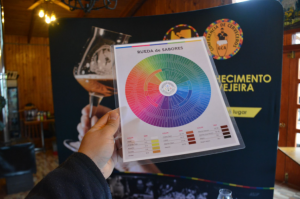5 experts in beer tasting were in charge of instructing more than 60 brewers, suppliers and workers in the field, in a workshop prepared to re-know the characteristics of emblematic beer styles.
By Lorenzo Palma Morales, Science in Chile.-The Los Ríos region remains at the forefront of craft beer production and there is an entire brewing ecosystem, says Daniel Trivelli, director of the IX Copa Cerveza de América 2022. This “ecosystem” is related to producers, consumers, suppliers, as well associated tourism, knowledge, technology and providers of different services.
Within the framework of this 2022 Cup and the FIC 22-09 project “Strengthening the management of regional product business nodes”, the experience of recognizing emblematic beer styles was organized. The participants were from the entire Los Ríos region, and were able to learn to correctly identify, using the appropriate technical language, the appearance attributes, aromas, flavors and mouthfeel of the different styles of beers.
What are the emblematic beer styles? For this training activity, Hefeweizen were chosen: Schöfferhof hefeweizen; Belgian Dubbel: Westmalle Dubbel; Saison: Dupont Saison; West Coast IPA: Thanks for the hops in See you soon; Imperial IPA: Better not to talk about certain things from Hasta Pronto; and Imperial Stout: Jester’s Cosmonaut. Have you tried any of them? It was one of the first questions at the beginning of the meeting.
“We chose these types of beer because they are a good starting point. They are characteristic in flavors and aromas in their style. They have flavors that stand out in malt, hops and fermentation. From this one can continue advancing in the recognition of styles”, commented Trivelli.
For the director of the current Copa Cervezas de América, another relevant aspect of this workshop is that people linked to the beer industry acquire knowledge that can allow them to improve their own production or think about what flavors, colors, and characteristics in general can consumers like it more. Marking styles, labeling products well and with this opens the possibility of being part of international beer competitions, such as the current Copa Cerveza de América 2022.
The workshop
The Pancul brewery is located 39 kilometers from Valdivia and more than 60 representatives of the brewing sector met there. This group was divided into five tables and, in each of them, they were provided with specialized beer glasses for the tasting and a flavor circle card, to record the characteristics of each of the emblematic beers, this process was guided by one from the beer experts. 
Patricio González was one of the five speakers who presented the different emblematic beers to the groups. Gonzalez has been a brewer for 12 years, he is currently a Growler brewmaster, he has also passed the online BJCP exam (The Beer Judge Certification Program or BJCP), various sensory analysis courses, Certified beer host at Cicerone and specialized courses in yeasts.
He, like the other experts, asked the participants questions about the type of beer they tasted. Do you feel the prevalence of alcohol? How do you see the foam? Do you recognize fruit aromas? Or how light is the beer in the mouth? They were some of the questions he asked the participants, who, drinking slowly and putting taste, smell and touch on alert, answered and completed the flavor sheet.
For Gonzalez, this workshop is important because it allows brewers to recognize beer styles and also learn about the beer style guide published each year by the Brewers Association, because it is used by judges who participate in international beer competitions. This workshop brought together part of these styles and introduced an associated technical language.
In the flavor sheet, the participants identified some characteristics of the styles and then checked if they were close to the description of each beer. Some with a better sense of taste than others, hit, for example, the typical malt flavor of the English Style Imperial Stout or the dense foam of the Belgian Dubbel; Saison: Dupont Saison.
On behalf of the Aguas Libre de Valdivia brewery, Lucas Chaura valued the workshop as it will allow him to learn about different styles of beer, carry out sensory analysis and also that this experience will help them to evaluate their own preparations.
Another specialist and guide for the workshop participants was Nicole Godoy, who is a Certified Beer Host at Cicerone, a member of the Women Brewers Community (CMC) and also did her undergraduate thesis on the history of Valdivia beers, which she titled “Soft liquor: sweet torment, women in the company of United Breweries of Valdivia 1930-1960”.
“This workshop is important, since brewers from different countries will participate in the 2022 Copa Cerveza de América and it is important that they speak the same common beer sensory language. This is quite lacking in the region. Training and instances like these where they share with people in the same field is very relevant”, Godoy commented.
It should be noted that the sensory analysis process was also guided by María Paz Calderón, who is a food engineer from the Austral University of Chile and a BJCP-certified sensory specialist; Pablo Enríquez, who was Junior Brewer for three years at Kunstmann; and Fuyen Chung, who is a BJCP Brewer Judge and Brewmaster at Greed Brewery.
This activity was carried out thanks to the project FIC 22-09 “Strengthening the management of business nodes of regional products”, financed by the Innovation Fund for Competitiveness (FIC) of the Regional Government of Los Ríos and its Regional Council and executed by the San Sebastian University (Valdivia Campus).














Add Comment